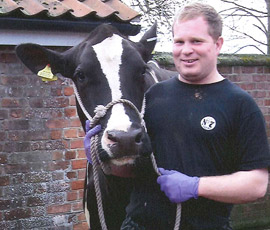Farmworker died trying to save colleague in slurry accident, inquest told

A farmworker died trying to rescue an unconscious colleague who was engulfed by a sea of slurry, an inquest has been told.
Paul Gray, 50, twice tried to rescue Craig Whipps (pictured), 27, who was emptying an above-ground slurry tank at Albyns Farm, Stapleford Tawney, near Ongar, Essex.
Both men died in the incident, which happened at about 5pm on Friday, 15 July 2011, Chelmsford Coroner’s Court was told on Monday (4 March).
Fellow farmworker Richard Brown raised the alarm when he discovered the tragedy after returning from spreading slurry on a nearby field.
“As I came back, there was slurry gushing out of the tower,” said Mr Brown, who also tried to rescue Mr Whipps. “He was laying on his back unconscious in the slurry.”
The slurry was waist deep, said Mr Brown, who was beaten back by the fumes. “I could feel my chest tightening up,” he told the court. “I am asthmatic – I felt sick and dizzy.”
Mr Brown used his mobile phone to call farmer Robert Torrance and emergency services. He also shouted for help from Mr Gray and farmworker Calvin Otto who were milking cows.
Rescue attempt
Mr Gray jumped over a wall to try to reach Mr Whipps, but he too was forced to retreat. Mr Otto also tried to rescue Mr Whipps but was overcome by the slurry.
Mr Torrance told the court how he hurried to the yard after receiving Mr Brown’s phone call saying there had a been a terrible disaster and there was slurry everywhere.
“I could could see Craig was submerged with his boot sticking up on top of the discharge pipe,” said Mr Torrance. Mr Otto was partially submerged face down in the slurry, he added.
Between them, Mr Torrance and Mr Brown dragged Mr Otto clear and put him in the recovery position away from the leaking slurry.
Mr Torrance then tried to rescue Mr Whipps while Mr Brown continued to receive instructions on his phone from the emergency services.
“I stood on top of the discharge pipe and tried to pull Craig up by his left arm, but it was too much,” Mr Torrance told the court.
Before losing consciousness himself, Mr Torrance said he saw Mr Gray jump into the slurry.
“I said: ‘Paul, get back, there’s nothing that can be done.’ I lost consciousness. I saw Paul getting out and that was the last I saw of him.”
Having seen Mr Gray get out of the slurry, Mr Torrance said after coming round his immediate concern and “number one worry” was for Mr Otto.
“Calvin was not breathing well at all,” said Mr Torrance. “I held his head off the concrete, albeit on the end of my Wellington – I wasn’t feeling in great shape myself at that point.”
“I said: ‘Paul, get back, there’s nothing that can be done.’ I lost consciousness. I saw Paul getting out and that was the last I saw of him.”
Farmer Robert Torrance
Mr Torrance said he assumed Mr Gray had managed to escape from the slurry, but it later turned out he had been overcome while making a second rescue attempt.
“I still didn’t realise anything was untoward with Paul,” said Mr Torrance.
The emergency services arrived within 10-11 minutes of the 999 call, the court was told. But it was too late and both Mr Gray and Mr Whipps were pronounced dead at the scene.
The jury was told that a valve on the side of the slurry tank had broken in the closed position.
HSE probe
A Health and Safety Executive (HSE) investigation concluded that Mr Whipps had removed a number of bolts retaining the discharge chute.
Removing the bolts allowed the slurry to gush from the tank with such force that Mr Whipps was unable to move away from the area and save himself, the court heard.
A number of bolts and a spanner missing from a toolkit belonging to Mr Whipps were recovered from the slurry after the accident.
HSE specialist inspector Bob Daunton told the court that disturbing the slurry in this way would have been “like shaking up a bottle of pop and letting the top off it”.
Mr Daunton said the incident would have released dangerous levels of poisonous gases – including hydrogen sulphide – which could cause a person to collapse in less than a minute.
“It is a very toxic gas,” said Mr Daunton, who measured hydrogen sulphide levels during a visit to the farm three days after the accident.
“We looked at the valve and drained a small amount of slurry and did some measurements,” he said. “Even at a low flow rate of litres per minute it was still significant.
“One of the measurements we got was off the scale of the instrument we had.”
A postmortem examination carried out by pathologist Nathaniel Carey found that the cause of death in both men was immersion in slurry.
The jury is due to give its verdict on Tuesday (5 March).
Read more articles on our health and safety news page.
